Hibiscus is a gorgeous flowering plant, and gardeners love seeing them grow repeatedly. Propagating Hibiscus is an economical way of getting more plants without repeated buying. But, can you grow them in water? Let’s find out.
Hibiscus doesn’t grow in water; you can root them in water, but you should move them in soil when new roots appear. Since they have deep and extensive roots, they need soil for nutrition and good holding. To root them in water, take a cutting from new growth and place it in the water.
Rooting a Hibiscus plant in water is ideal for beginners and a fun project. This article will guide you with all the steps to grow Hibiscus in water and other relevant details regarding water propagation.
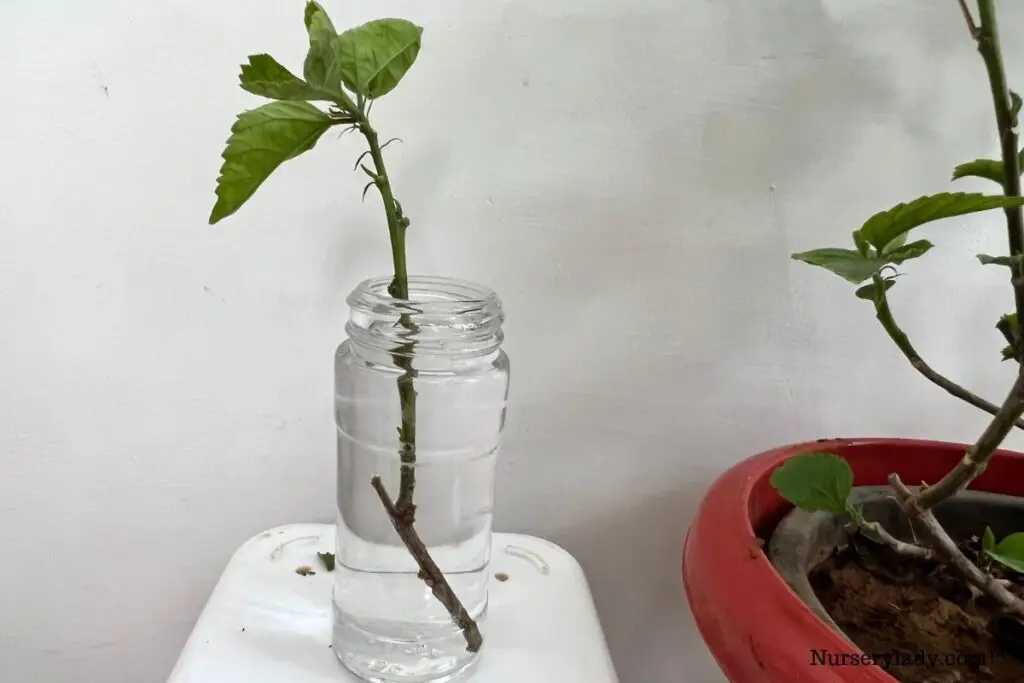
Will Hibiscus grow without soil?
If you want your Hibiscus plant to stay alive for a long time, you should grow them in soil.
But that doesn’t mean you can’t propagate them in water.
Hibiscus will grow both in soil and water.
They grow roots faster in water than in the soil.
But, you should transplant them to the soil when they develop roots and new leaves while in water.
Since their roots are deep and extensive, they won’t be able to stay for a long time in the water.
They will need soil to hold up the roots.
Generally, while rooting in water, go for the softwood parts.
They are yet to mature and can root well in water.
But, if you have cut the woody stems, grow them in the soil.
Since they will take time to grow, soil can provide them with all the necessary nutrients for faster rooting.
Soil propagation is important if you want the Hibiscus to grow into a shrub.
You don’t have to transplant them, and thus, it can reduce the risk of transplant shock.
Growing Hibiscus in water is great for beginner propagators.
Besides, it is fun to see how it performs in the water.
Also read: How Fast Do Hibiscus Plants Grow? (Hibiscus Growth Rate )
Things to remember while rooting Hibiscus in water
There are a few things to know while rooting Hibiscus cuttings in water.
It will help in successful water propagation.
The time of propagation
Wait for the summer to arrive if you want to propagate.
Take the cuttings in the middle of the summer.
Since Hibiscus plants are summer growers, they will grow vigorously and thus, give you a better chance of propagation.
If you do it in the late summer, the stems will become hard, mature, and woody.
This type of stem will take time to grow new roots.
Choosing cuttings
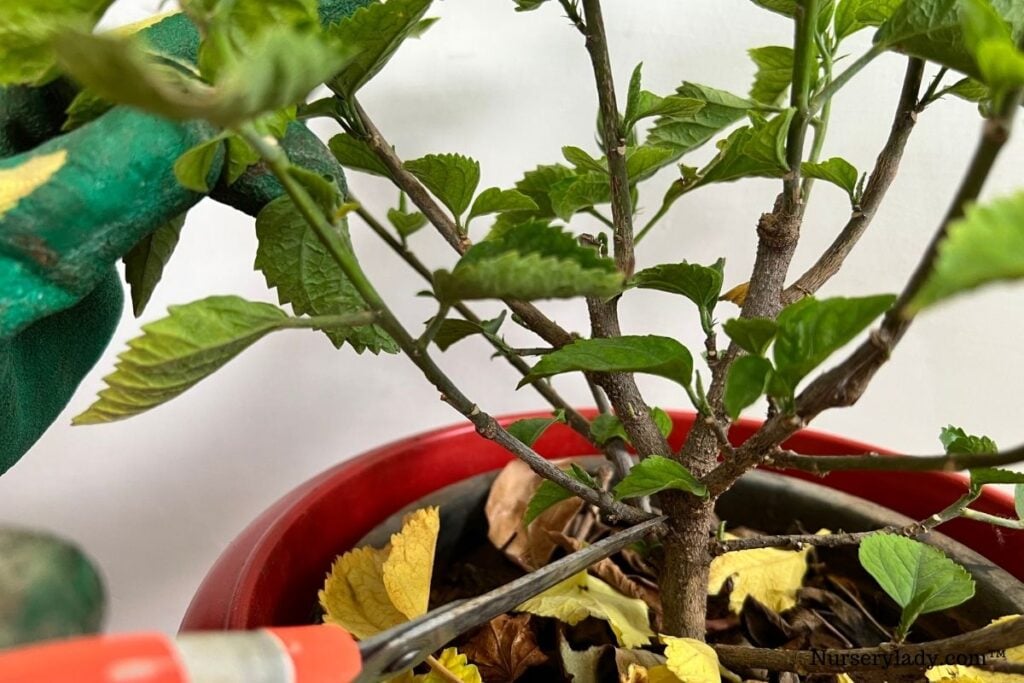
When it is about cuttings, it is classified into three parts: tip cutting, medium woodcutting, and hardwood cutting.
Tip cuttings are softwoods that have not yet begun to mature and grow in summers.
This helps in faster growth vigorously.
Medium wood cuttings are softwood that has already started to mature.
These cuttings are usually separated in autumn.
It takes a lot of time to grow new roots.
You will rarely find any growth until the winter is over.
Hardwood cuttings are taken during the last winter months or in early spring.
This is usually the pruning time to encourage flowering.
So, you can use this moment both for pruning and propagating.
You must take the softwood and propagate them in summer for water propagation.
It encourages new growth faster within a few weeks.
The plant
Though we will select the newly grown stems, the mother should be mature and healthy.
If your plant faces or has faced any stress recently, don’t take the cutting from that plant. Find a healthy plant.
If you don’t have any other plant, wait for some more months to let your plant heal more.
Don’t take too many cuttings.
Taking too many cuttings will make the plant empty and weak and further stop growing.
You should not take more than 5 to 6 cuttings from the plant.
Looking for gardening supplies? We have tested 100's of products before recommending them to you guys. Check out our best pick below:
| Image | Gardening Supplies | Best Price? |
|---|---|---|
 Top
Top Top
Top | Raised Garden Bed Kit | Check On Amazon |
 | XLUX Soil Moisture Meter, Plant Water Monitor, Soil Hygrometer Sensor for Gardening, Farming, Indoor and Outdoor Plants, No Batteries Required | No Results |
 Top
Top Top
Top | 82 Pcs Garden Tools Set and Extra Succulent Tools Set | Check On Amazon |
 | Joeys Garden Expandable Garden Hose with 8 Function Hose Nozzle, Lightweight Anti-Kink Flexible Garden Hoses, Extra Strength Fabric with Double Latex Core, (50 FT, Black) | No Results |
 Top
Top Top
Top | Dual Chamber Compost Tumbler | Check On Amazon |
 Top
Top Top
Top | Sunnyglade Plant Stakes | Check On Amazon |
 Top
Top Top
Top | Organic Cold Pressed Neem Seed Oil | Check On Amazon |
 Top
Top Top
Top | Mighty Mint Gallon :-Insect and Pest Control Peppermint Oil | Check On Amazon |
 Top
Top Top
Top | Scotts DiseaseEx Lawn Fungicide | Check On Amazon |
 Top
Top Top
Top | Jacks Classic 20-20-20 All Purpose Fertilizer | Check On Amazon |
 Top
Top Top
Top | 30,000 Seeds Pollinator Attracting Wildflower Mixture | Check On Amazon |
 Top
Top Top
Top | Survival Vegetable Seeds Garden Kit-Over 16,000 Seeds | Check On Amazon |
Use transparent jars
Using transparent jars will help you see the development of the roots and the water condition.
However, you can use any jar or vase of your choice.
Clean the jar before using it to eliminate bugs or spores.
Use distilled water or rainwater.
Distilled water or rainwater is pure and free from all the harsh minerals.
You can also use tap water only if it is allowed to sit for 2-3 days.
How to grow Hibiscus cuttings in water? – Step-by-step guide
Growing Hibiscus in water is very easy, and it saves a lot of time.
It is also good and easy for gardeners who attempt propagation for the first time.
So, let’s dive into the guide without further delay.
Materials required:
- A knife
- Clean glass or jar
- Rubbing alcohol
- The Hibiscus cuttings
- Rooting hormone
- Warm water
- Hydrogen peroxide
Step 1
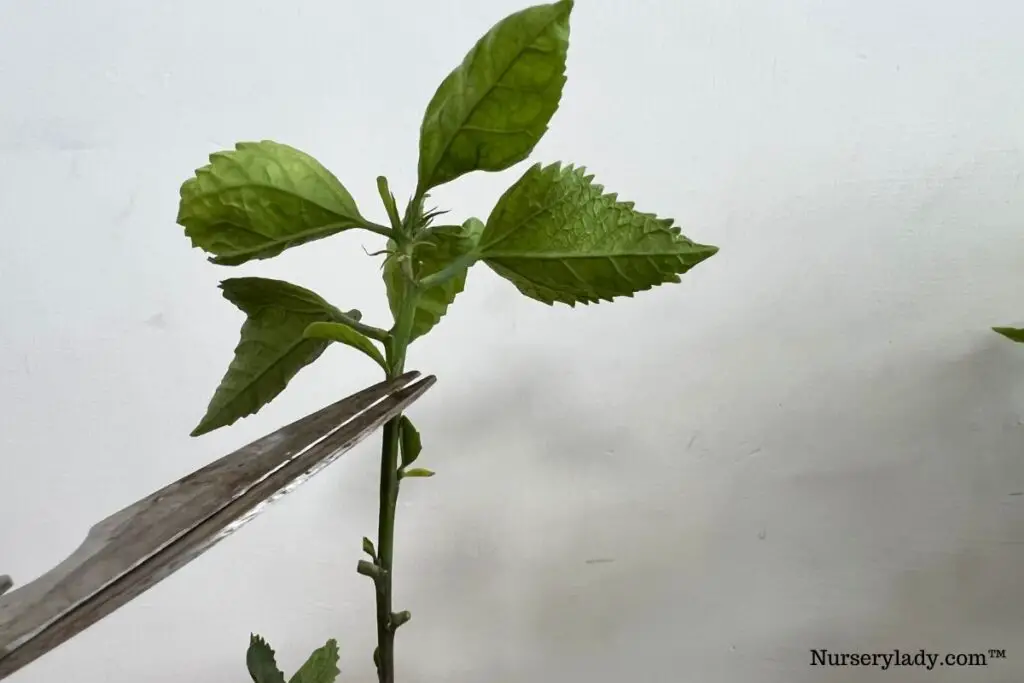
Selecting a healthy mother plant is the best choice.
The cuttings from a healthy plant can increase the chances of successful propagation.
Step 2
Gather the cutting in the morning.
It is the time when the plant remains cool and hydrated.
Take a cutting from softwood.
The stems will be a bit greenish and bend easily.
Softwood cuttings are new growths and encourage faster rooting.
Though they root best, the propagation process should start immediately.
Otherwise, the cuttings will dry.
Find the smooth stems with dark green leaves.
Step 3
Spray some rubbing alcohol on the pruning shears to disinfect them.
Next, cut the green branches about 4 to 6 inches.
Don’t collect too many cuttings as that can make the plant naked, and it may stop growing.
Trim only 4-5 cuttings at a time.
Step 4
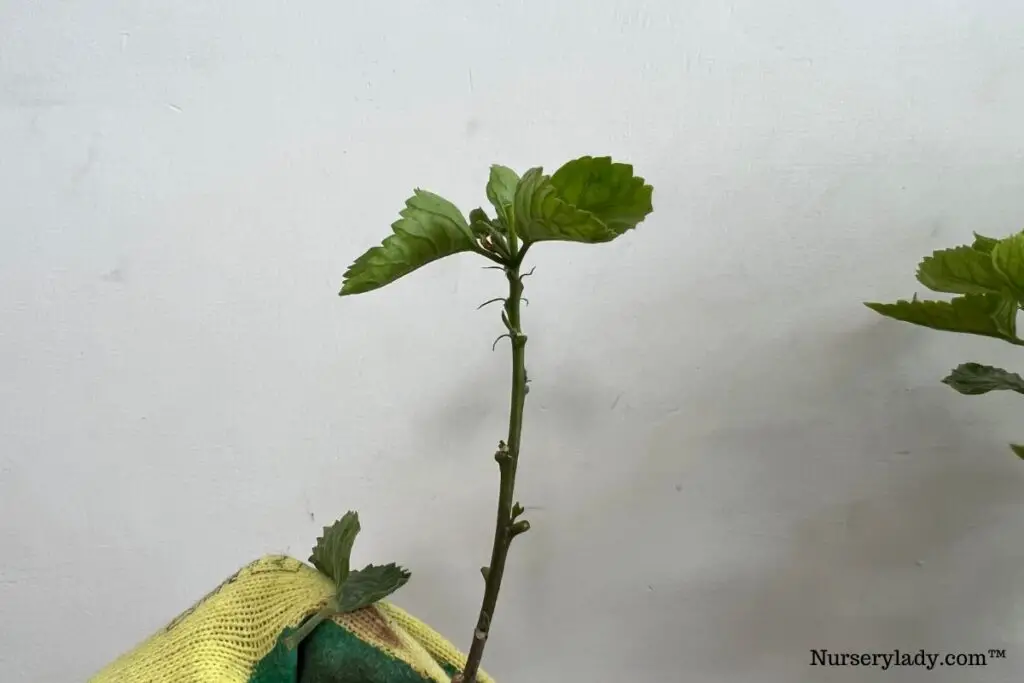
Remove all the leaves with the same pruner. Leave behind 1-2 leaves at the top.
If the top leaves are big, cut them halfway horizontally to prevent wilting.
Removing the leaves will encourage the plant to focus on root growth instead of the foliage.
Step 5
Now, cut the base of the cutting around 0.25 inches below the node diagonally at a 45° angle.
It will increase the surface area of cutting to absorb water.
You can also cut through the place from where the leaf was growing.
It has as natural growth hormones.
At the base of the stem, scratch a little around 1-2 inches at 1-2 sides to expose the cambium layer.
It will increase the area from where the roots will grow.
Step 6
Dip the end of the cutting into the rooting hormone.
Rooting hormone is a powder that will help your cutting develop new roots from the young cells.
Directly dip the stem end into the powder.
Step 7
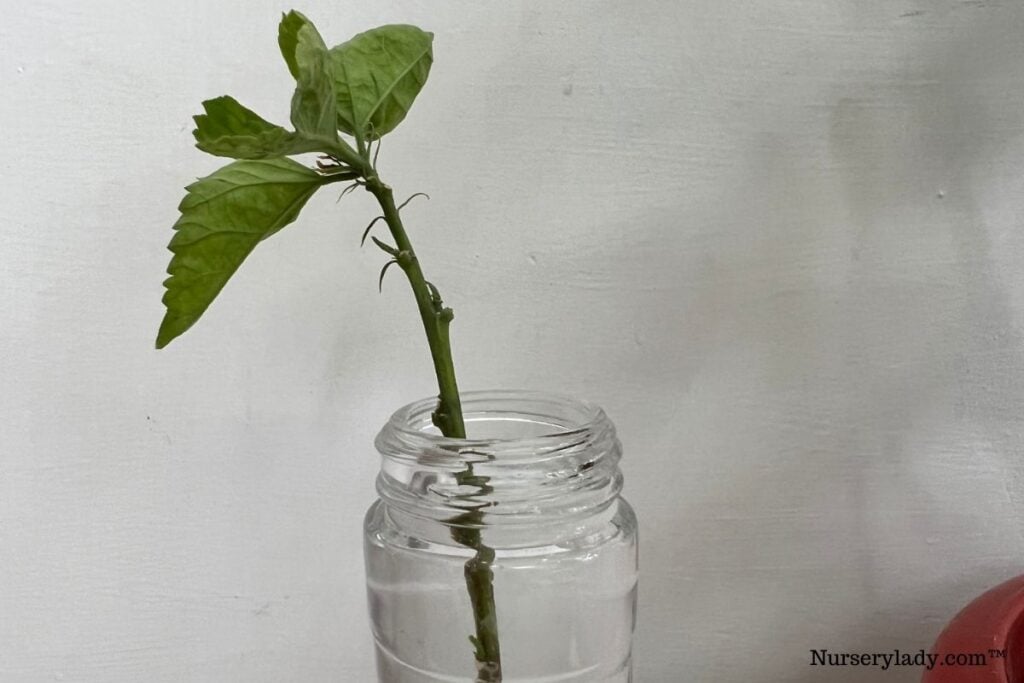
Now, take a glass or a transparent jar and fill 2-3 inches of it with water.
The water should be either distilled or rainwater.
Use warm water (not hot water) and add 1-2 drops of hydrogen peroxide.
The warm water will save the plant from shock, and hydrogen peroxide helps fight fungal diseases.
Step 8
Place the container under indirect sunlight.
Don’t let them have direct sunlight until they grow a little bigger.
Else, they will get stressed.
Keep them indoors near a sunny window and put on the sheer curtains to filter the direct sunlight.
Make sure the temperature in the room remains around 70°F.
If the cutting displays signs of wilting, move them to a shadier and cool place.
Step 9
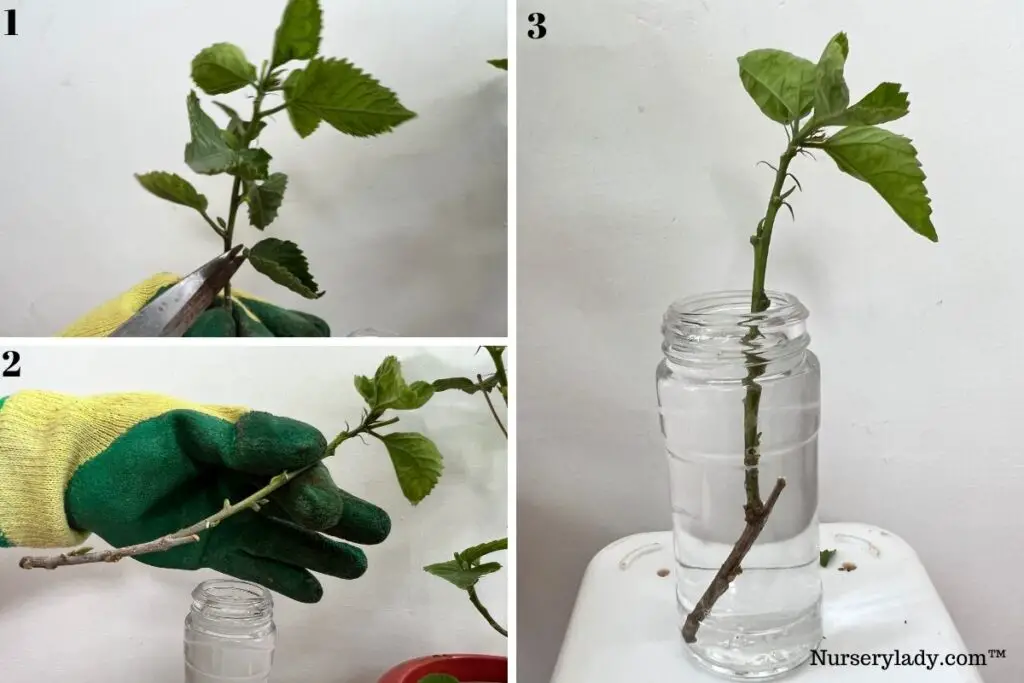
Check the water daily and change it every 2-3 days.
Rinse the jar or the glass properly and add new water and cuttings.
You can find white bumps within 7 to 10 days.
Within 4 to 6 weeks, you will find them developing into roots.
Should I transplant the cutting into the soil or let it grow in water?
Since Hibiscus plants have deep and extensive roots, they will need soil to hold the roots.
The soil will also provide the plant with enough nutrition that water won’t be able to give.
That is why you must transplant them into the soil.
When the cutting grows new leaves at the top of the stems, it is time to transplant it.
You can also check it from the roots.
When the cutting is ready for transplanting, the roots will change from white to a light tan color.
How to transplant?

You should try and keep them in containers until they are full-grown plants.
When you transplant a full-grown plant to the ground, it can endure and recover from transplant shock quickly.
Take a small 4-inch planter.
Also read: What Kind Of Pot Is Best For Hibiscus? (Size, Material & More)
Fill it with the ideal potting mix, and leave 1-inch from the top.
Dig a hole around 3 inches deep and plant the cutting.
One container should have one stem.
For potting mix, you can use:
If the leaves ever touch the soil, they will rot.
Check that the cutting is not planted too deep, and the leaves shouldn’t touch the soil.
Place the container at a location that receives filtered sunlight for two weeks and water regularly.
Since they are growing, they need water to develop.
If the soil is wet, reduce watering.
Drench them only when the top 1-2 inches are dry.
To transplant this potted plant into the garden ground permanently, you have to harden the plant.
Place the plant in a cool area for 2-3 days and then outside in a shady area again for 2-3 days.
Choose an ideal location for planting, a site that receives daily 6-8 hours of sunlight, well-drained, and permeable soil.
Also read: What Kind Of Soil Does A Hibiscus Plant Like? (+Best Soil Mix)
What are the pros and cons of growing Hibiscus in water?
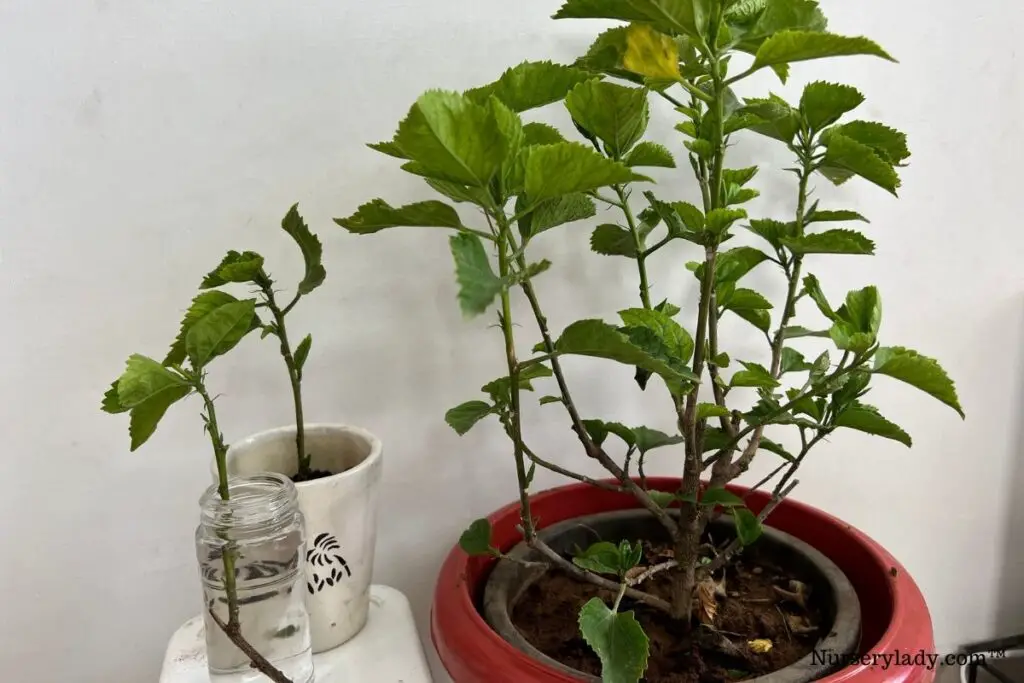
Everything has a good side and a bad side.
So, water propagation will have pros and cons.
You need to understand both sides of the coin before taking it.
| Pros | Cons |
|---|---|
| Soil propagation takes a lot of time and effort, like buying the right container or the ideal potting mix. But in water propagation, all you need is the cutting and a glass of freshwater. | It is not a permanent place for Hibiscus. Hibiscus won’t last long in water because they need enough space to spread their extensive roots, and soil can hold them. |
| In water propagation, you can track the roots’ development and know the water’s condition, which is not possible in soil propagation. | Soil mix contains many nutrients which can encourage the plant to grow. Besides, you can provide them with adequate fertilizer. |
| Growing Hibiscus in water can reduce the chances of pests and diseases which have high chances in the soil. | You have to change the water frequently. It is a wastage of water. |
| Root growth is faster in water than in the soil. | There are chances of algae formation if you become ignorant about changing the water. |
| It requires less attention. You only need to change the soil for some days or months. | The roots can rot after staying in water for such a long time. Move them to the soil when the roots turn a light tan color. |
| You can keep multiple cuttings in one single glass or jar. |
Tips for a successful propagation
- When you start to gather cuttings for propagation, collect the cuttings simultaneously and not on separate days. It can give you multiple plants at a time.
- You can use honey or cinnamon instead of rooting hormone.
- Don’t touch the cut portion with your hands. That can transfer oil can block the function of the rooting hormone.
- Summer is the best time to propagate. Softwood cuttings give the best and fast results.
Final thoughts
Hibiscus plants are beautiful flowering plants found in most gardens in tropical areas. Propagating Hibiscus is good for beginners and fun for all the gardeners. Besides, it works quickly and needs minimum effort.
You need some softwood cuttings, glass, or a jar filled with pure water. Place the cuttings in it and place them under indirect sunlight. And, it is done. Change the water regularly.
When the cuttings develop, some new leaves at the top of the roots become slightly tan-colored. Transplant them in pots with the ideal soil mix. Water the plant regularly as they need it for their ongoing development.
When the plant has fully grown, find a permanent place in your garden and plant the plant directly in the ground. Water the plant daily and make sure that it receives sunlight for 6-8 hours daily.
Also read: How To Propagate Hibiscus? (4 Methods+Step-By-Step Guide)
Reference: Wikipedia, ASPCA, Louisiana State University Agricultural Center, American Society for Horticultural Science, Tropical Hibiscus by Texas A&M University, Sciencedirect.

